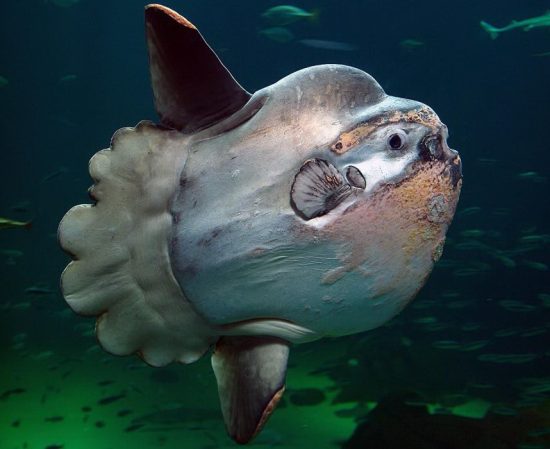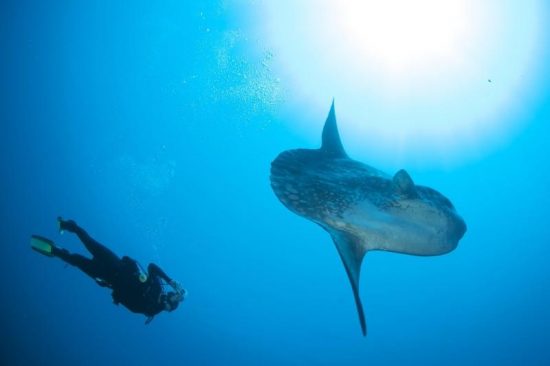



Floating "Millstones" In The Ocean?
At first glance, these curious-looking fish look like gigantic fish
heads without a body. They are known as “sunfish” in English and
“mondfisch” in German. Although the two names are indeed descriptive,
the fish's scientific name – Molidae, which comes from the Latin word
mola (meaning “millstone”) – perhaps best describes their unique body
shape.
Info on Sunfish
English: Sunfish, German: Mondfisch (Moonfish)
Family: Molidae
Species: 3
Best-known representative species: mola mola
Size: Up to more than 3 feet high and almost as long
Weight: Up to 2 tons
Habitat: Offshore resident that sometimes stops by at the coast
Distribution: Worldwide in warm seas
Seeing a sunfish up close is a unique experience. The animal has a
large head with one fin each on the top and bottom of its massive body.
It has no scales, but a thick leathery skin that is several centimetres
thick. Its body comprises a gelatinous mass of cartilage (no bones!).
Additionally, it is a teleost (ray-finned fish).
Sunfish do not have a swim bladder, an organ which in other animals
would give controlled bouyancy. However, the sunfish has no need for
it, as its body tissues has a density of 1.03g/cm3, similar to that of
seawater. This allows the fish to maintain its bouyancy despite
swimming to increasing depths.
Triple world champion?
2.3 tonnes: The heaviest recorded sunfish specimen topped the scales at
2.3 tonnes as the world's heaviest bony fish (Teleostei – yes, indeed -
no bones but belongs to the family of teleosts).
300 million eggs: When the female spawns, at least 300 million eggs are
released. However, there's no need to worry about our seas overflowing
with sunfish – most of the eggs and larvae end up in the stomachs of
other fish.
0.25cm to 1,000cm: That's how much “growing” the 0.25cm larvae will do,
as it grows into adulthood. Its weight gain is just as impressive: In
just 15 months, a sunfish managed to gain 373kg while in captivity.
That works out to 0.82kg per day!
Research
Limited funds have been set aside for the sunfish, as they do not have
any commercial interest. However, with its fins above and below its
body, the sunfish's movements have become quite efficient, as shown by
experiments in the flow channel. The GPS system has also tracked the
sunfish worldwide, confirming that covering distances of 2,000
kilometres in three months is not uncommon for the sunfish.
Parasites
Sometimes, sunfish lie flat on the seabed, as if they are basking. So
far, we have not found out why they do this; one theory suggests that
sunlight and UV radiation may help to expel parasites (though this has
not been confirmed). In the open seas, there are no cleaning stations.
Thus, to get rid of parasites, the sunfish sometimes leap into the air,
and then turn their bodies horizontally so they crash back onto the
ocean surface with a big splash, much like how whales remove the
parasites from their bodies.
 Herbert
Herbert 1st September 2015
1st September 2015